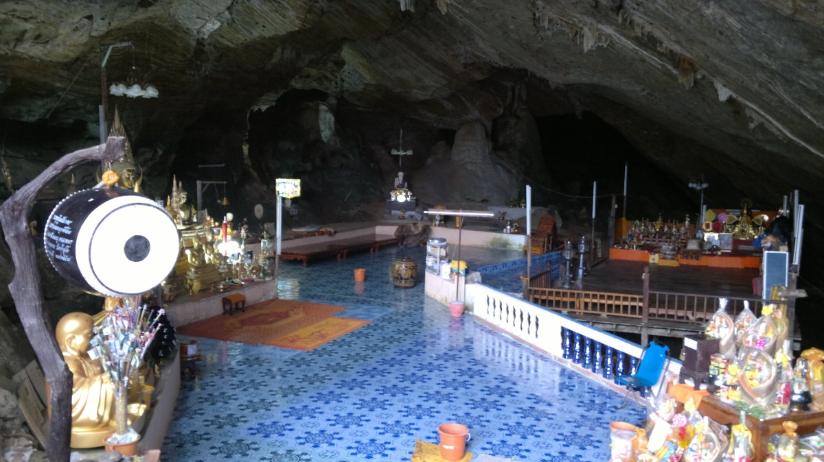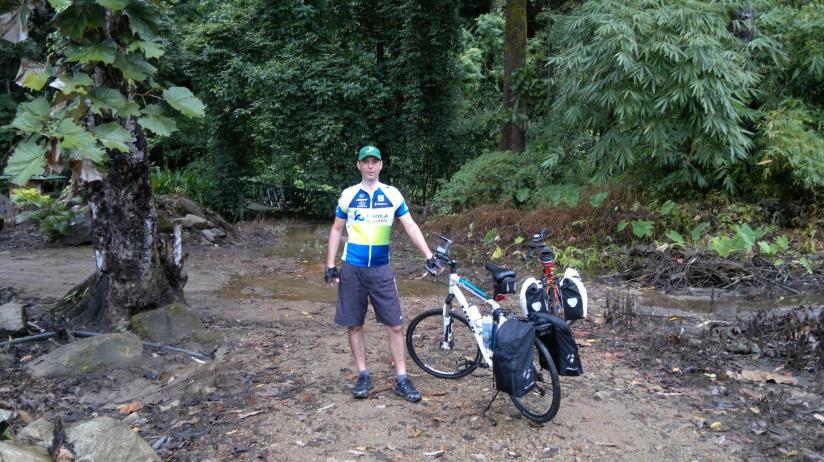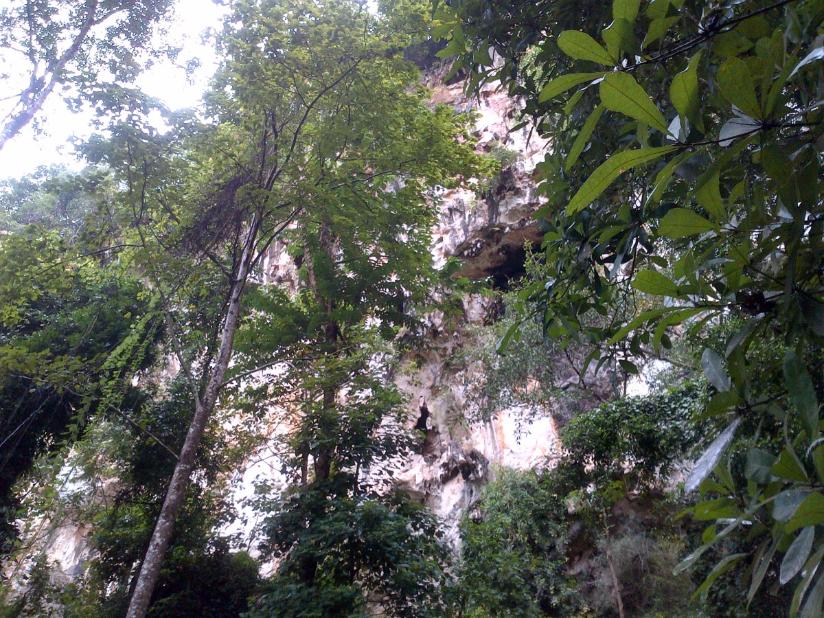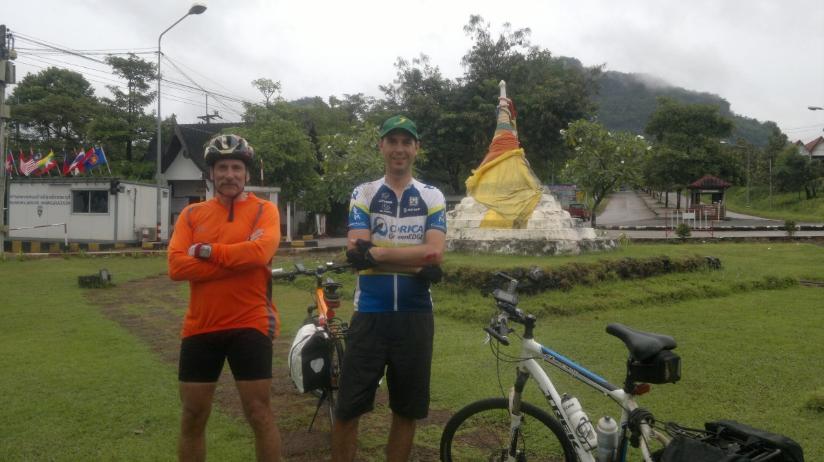5 November 2014
- A3PPABT5: Chalae - 3PP- Sangkhlaburi Bicycle Track
- General data:
- We started our bike trip at the Phatsapada Resort in Chalae and ended the fifth bicycling day at the P. Guesthouse in Sangkhlaburi.
- Technical data of the trip was as follows: Total Distance: 87.01 Km; Moving Average: 18.5 Km/Hr; Overall Average: 13.4 Km/Hr; Maximum Speed: 53.1 Km/Hr; Moving time: 4 Hr 42 Min; Stopped Time: 1 Hr 47 Min; Total Time: 6 Hr 29 Min.
- Number of participants: 2 (Pat & Steve)
It just stopped raining as we departed from the Phatsapada Resort. We drove into the Khao Laem National Park and this ride was going to be the summit of our bike tour. After 15 minutes we arrived at the Kroeng Krawia waterfall situated along the roadside. The fall cascades down a limestone rock face under shady trees. We made a photo stop and continued on our track. At 0700 Hr we saw the first glimpses of the Khao Laem Reservoir. The reservoir was formed when the Khao Laem Dam, later renamed the Vajiralongkorn Dam, was constructed in 1985. The blockage of the Khwae Noi River flooded the entire area from a little beyond Ban Ongthi to just before Sangkhlaburi. The reservoir is fed by three rivers being the Songkalia, the Bikhli and the Ranti. The Death Railway track in this area became submerged under the waters of the Khao Laem reservoir. There had been caves enlarged along the hillsides into which trains could enter to escape the increasingly frequent allied bombings during WWII. In 1974, in one of such caves, a group of Australians, located the abandoned Japanese C56 steam locomotive (C5623 - Thai numbering 719) now displayed near the Tha Makham bridge in Kanchanaburi. We enjoyed the view when biking along the banks of the reservoir. At Km 24 before tackling a steep climb from 180 m ASL to 400 m ASL we made a rest stop. I said to Steve we should be glad it stopped with raining on our departure. My words weren't yet totally expressed or it started to drip again. It would rain quasi throughout the rest of the day. While Steve continued along the track I made a photo stop at the Khao Laem National Park office and at the Sukho Cave. Tham Sukho is a large limestone cave just off the Asian Highway 123; within the cave is a shrine.

Our next rest stop was at Wat Lijia and the cave in its vicinity. We climbed up unto the foot of the cave. The treasure hunter community from the late nineties seems today to be replaced by a meditation retreat. There has quite been a rush around the Lijia Cave. Chaowarin Lathasaksiri claimed in 1995 already that there was Japanese loot stashed in the cave. The senator based his claim on a story told to him by an elderly monk who used to meditate in the caves, close to the route of the infamous Thai-Burma Railway. Phra Aphisit Thammavaro said to have found a steam train with two bogies fully laden with gold bars, a plane, samurai swords, steel boxes, rice milling equipment and the remains of several Japanese soldiers who had committed suicide, when he entered a cave. The monk drafted a map. The news triggered a small gold rush to the area. Chaowarin also led a team of men into the jungle to search for the gold. The gold fever lingered on. On Sunday 23 July 2000 six treasure hunters died from suffocation in the cave. Police had to retrieve the bodies of four men and two women.

After Senator Chaowarin Lathasaksiri announced again that he had found evidence of the treasure left behind by the Japanese at the end of WWII, with a value which could wipe out Thailand's national debt; and the visit of Prime Minister Thaksin Shinawatra the week prior to the area, the Thai government started an official treasure hunt on 16 April 2001 into the labyrinth cave of Lijia. A 3 million Baht, 21 m long and 30 Ton capacity bridge was donated by a state agency to connect the cave with the forest ground. A 60-member team, comprising army troops and experts from forestry, fine arts and mineral resources department and armed with rock breaking equipment, drilled through blocked portions of the cave for seven days. Over 400 policemen and forestry officials were deployed around the area to keep at bay the hundreds of people who gathered outside the Lijia Cave. The use of explosives caused the mouth of the cave to become blocked with a pile of rocks. Despite extensive searches no treasure was found inside the mountain. The Thai government faced serious embarrassment when it halted the search for the Japanese treasure amid growing evidence of a huge hoax. Anyway maybe they were just too late …

In the 90's stories were told that ten years earlier a group of elderly Japanese, presumed to be ex-soldiers of the Japanese Imperial Army, together with some younger men, arrived in army trucks with a great deal of equipment said to have been loaned by the Thai army. The group located and confirmed the hill cave using old black-and-white photographs and maps they had brought with them. They had worked in the area, exploding the cave's entrance and using a great deal of equipment, for three days, during which the local villagers had been kept away at gunpoint. On the morning of the fourth day, the villagers found that the Japanese group had completely disappeared, silently leaving during the previous night. Speculations went on regarding the money obtained for the construction of a number of Japanese Memorials in Kanchanaburi area; the enormous amount of wealth in the will of the late General Sunthorn Kongsompong, a top-ranking leading military officer at the time of the alleged Japanese attempt to recover the Lijia treasure; and the donation of 12 Ton gold bullion by the late Buddhist monk Luang Ta Maha Bua to Prime Minister Thaksin Shinawatra in 2002 to help fill the state coffers; linking all that unexplained wealth to the treasure of the Lijia Cave.

We returned to the main road and continued in direction of Sangkhlaburi. Nearly arriving at the bridge over the Ranti River, one of Steve's panniers came lose and got stuck in his wheel. The road was wet and Steve got two choices; either run into the road protection barrier or make a controlled slide into the grass. He chose for the second option and came slightly bruised out of the incident. A first help kit is always useful in these cases. Steve cleaned out his wounds and after a couple of minutes of rest we were back on the road again. After a while we turned right at the crossroad on the edge of Sangkhlaburi and climbed slowly up about 150 meter in altitude to the Three Pagoda Pass. One kilometer before arriving at the three pagodas we were offered a steep descent right to our target. We stood before the three chedi at 1111 Hr, our objective reached and half way our tour. The three pagodas were formerly three piles of stones which marked the pass; hence the location's former name ‘The three stone piles’. Later the piles of stones were covered by chedi. This area was a border pass intensively used by Thai and Burmese armies since the first Burmese attack on Ayutthaya in 1568/69 AD until the war of the nine army forces at the time of King Rama I (1785 AD). It also marks the rugged Thailand-Myanmar border and is the site of a small thriving border market. Thus it was time for a coffee at one of the shops surrounding the three piles of stones. After finishing the coffee, I forgot my bike helmet at the shop. The owner ran behind me to return my helmet as we were walking slowly to the chedi and on that occasion we asked him to take a picture of us.

We left the border area at 1145 Hr, directly engaging the tough climb. Once at the top, it went only down to Sangkhlaburi. The town known by the Japanese in WWII as Sonkurai, and today populated mostly by Mon and Karen people, sits on the edges of the northernmost extremities of the Khao Laem Reservoir. We reached the Sangkhlaburi crossing about 45 minutes later, climbed up to Wat Somdet marking the entry of the city and arrived at P Guest House at 1300 Hr. As the bad weather continued we remained at the guest house for the rest of the day and I used the occasion to clean my bike and to relax.